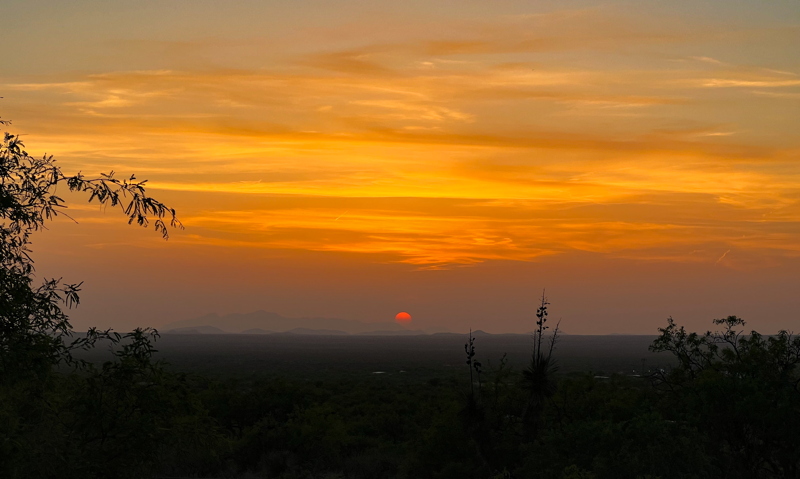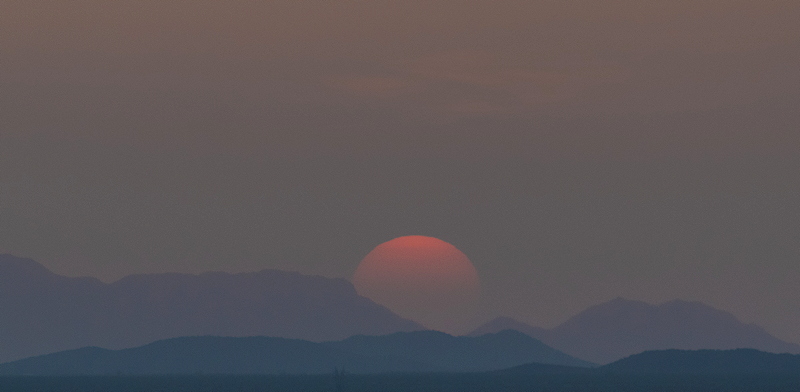Sun, Supernova 2022hrs (iPhone & DSLR),
M68 Globular Cluster
Posted: 26 April 2022
|
Open: Monday, 25 April 2022, 1825 MST Temperature: 91°F |
Session: 1754 Conditions: Mostly clear, hazy, smoke |
Equipment:
12" f/8 LX600 w/StarLock
2" 24mm UWA eyepiece
2" 30mm eyepiece
1.25" 26mm eyepiece
Camera:
D850 DSLR
iPhone 13 Pro Max
SYNCed observatory clock to WWV time signals.
1832 MST: Began relaxing on the observatory patio bench.
1859 MST: I moved to higher ground and began photographing the setting Sun using the D850 DSLR (focal length 240mm and 300mm) and iPhone 13 Pro Max. Five sunspots are visible in the DLSR photos.

Mouseover or tap on image for labels



1904 MST: Sunset.
1930 MST: Back inside the observatory. Prepared the D850 DSLR for imaging.
1936 MST: LX600 ON, StarLock OFF.
Slewed to M68 (globular cluster). It was not yet visible in the twilight sky.
1949 MST: While looking into the eyepiece to try to view M68, 102X, I saw three satellites pass through the field-of-view. They were separated by about 2 seconds, of the same brightness, and on the same apparent path. They were probably SpaceX Starlink satellites.
1952 MST: M68 was now faintly visible in the twilight sky, 102X.
I then viewed M60 (galaxy), NGC4647, and Supernova 2022hrs in NGC4647, 102X. The supernova was visible in the twilight sky using averted vision. It is reported to be brighter than Mag. +13 now.
2000 MST: Supernova 2022hrs was visible without using averted vision, 81X.
Attached my LiDAR Cover to the iPhone 13 Pro Max and mounted it on the 30mm eyepiece using the Levenhuk adapter.
2009 MST: StarLock ON.
Took this StarLock autoguided, afocal 81X, image of M60 (galaxy), NGC4647, and Supernova 2022hrs using NightCap Camera (Long Exposure, Light Boost, ISO 32000, 1sec, 1 minute, 1X lens). Seeing was not good and autoguiding was not accurate, hence some star trailing during the exposure.

Mouseover or tap on image for labels
I then mounted the D850 DSLR at prime focus, focused on the star Vindemiatrix, and locked the 12" primary mirror. I noticed that clouds (and smoke?) were coming in, which created challenges in imaging the supernova. I was able to get this StarLock autoguided image of M60 (galaxy), NGC4647, and Supernova 2022hrs, 5 minutes, ISO 3200.

Compare the above image to one I did on 30 April 2017 using a D7200 DSLR. Conditions were better than night.

2057 MST: Removed the camera and viewed Supernova 2022hrs, 102X. It was easily seen.
Then viewed M68 (globular cluster), 102X and 94X. Mounted the iPhone with the LiDAR Cover on the 26mm eyepiece. Took this StarLock autoguided, afocal 94X, image using NightCap Camera (Long Exposure, Light Boost, ISO 16000, 1sec, 1 minute, 1X lens).

2113 MST: StarLock OFF.
2117 MST: LX600 OFF.
Due to the smoke in the sky, I decided to not do a sky quality reading.
|
Close: Monday, 25 April 2022, 2126 MST Temperature: 67°F |
Session Length: 3h 01m Conditions: Mostly clear, smoke |
Comments are welcome using Email. Twitter users can use the button below to tweet this report to their followers. Thanks.
Cassiopeia Observatory Home Page
Copyright ©2022 Michael L. Weasner / mweasner@me.com
URL = http://www.weasner.com/co/Reports/2022/04/26/index.html
